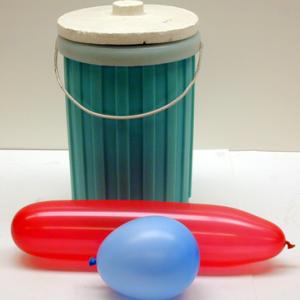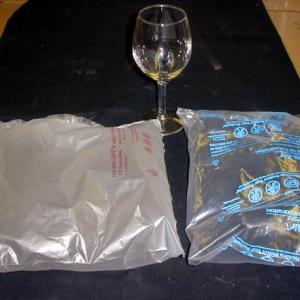College of Liberal Arts & Sciences
4E10.20 - Liquid Nitrogen - Balloons
See also 4E10.20 in Heat and Fluids
Arrange ahead of time to get liquid nitrogen from Biochem stores. Typically it takes about 4 liters for each classroom demonstration.
Blow up balloons and put them into the nitrogen and they will contract to a very small volume. Let them warm up on the table and they will expand to their original size.
NOTE: when the balloon is frozen in liquid nitrogen the small amount of liquid that appears in the balloon is liquid oxygen and may have a slightly bluish appearance. It may be more visible to break the balloon and pour this liquid into a wine glass. Instead of balloons you may also use air cushion packs that come as packing insulation. These are usually clear to make the liquid oxygen visible and they are fairly easy to tear to pour the liquid oxygen out.
The temperature of liquid nitrogen should be a -196o C or approximately 77o K.
- Clyde J. Smith, "Archimedes' Principle Meets Charles' Law", TPT, Vol. 17, # 3, Mar. 1980, p. 187.
- A. J. Moreno, H. Ferrari, V. Bekeris, "Cooling Balloons with Liquid Nitrogen", AJP, Vol. 78, # 12, p. 1312, Dec. 2010.
- Hk-3: Freier and Anderson, A Demonstration Handbook for Physics.
- H-078: "Objects in Liquid Nitrogen", DICK and RAE Physics Demo Notebook.
- Imelda S. Caleon and R. Subramaniam, "Liquid Nitrogen Turns Down the Temperature on Gas-Law Demos", Physics Education, Vol. 39, # 4, July 2004, p. 324
- Brett Carroll, "Buoyancy Demonstrations with Helium Balloons", PIRA Newsletter, Vol. 1, # 5, p. 5, Sept. 1986.
- Gordon McComb, Lasers, Ray Guns, & Light Cannons - Projects from the Wizard's Workbench, pp. 28.
Disclaimer: These demonstrations are provided only for illustrative use by persons affiliated with The University of Iowa and only under the direction of a trained instructor or physicist. The University of Iowa is not responsible for demonstrations performed by those using their own equipment or who choose to use this reference material for their own purpose. The demonstrations included here are within the public domain and can be found in materials contained in libraries, bookstores, and through electronic sources. Performing all or any portion of any of these demonstrations, with or without revisions not depicted here entails inherent risks. These risks include, without limitation, bodily injury (and possibly death), including risks to health that may be temporary or permanent and that may exacerbate a pre-existing medical condition; and property loss or damage. Anyone performing any part of these demonstrations, even with revisions, knowingly and voluntarily assumes all risks associated with them.

